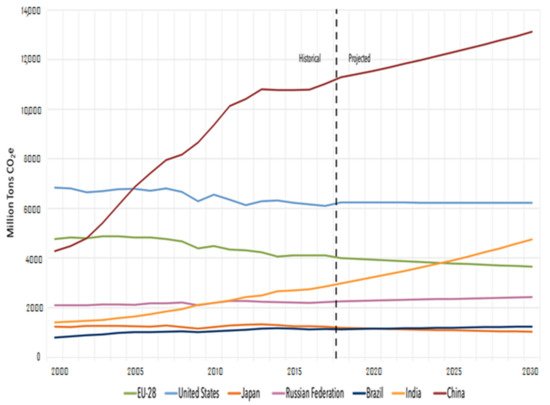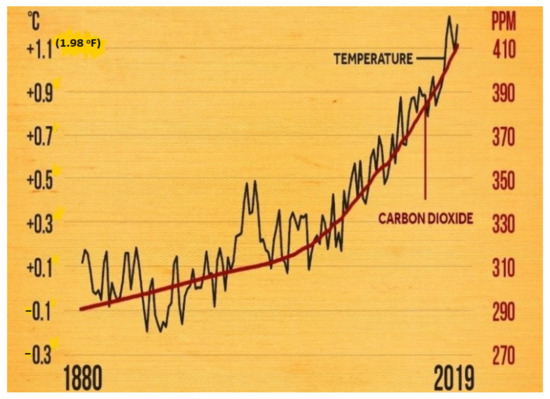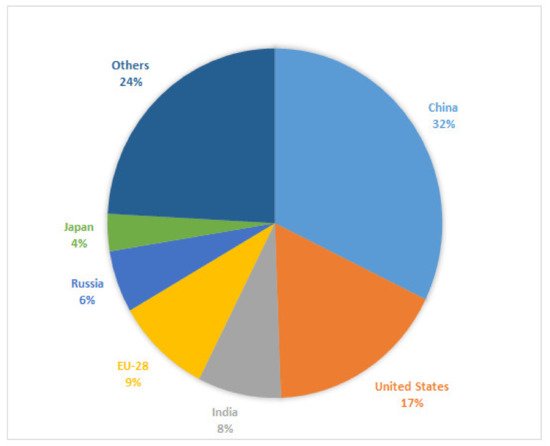You're using an outdated browser. Please upgrade to a modern browser for the best experience.
Please note this is a comparison between Version 1 by Oyetola Ogunkunle and Version 2 by Lily Guo.
Air pollution is a precursor to many health issues such as difficulty breathing, asthma, lung and heart diseases, and cancer.
- Air pollution
- environmental sustainability
- biofuel combustion
- gaseous pollutants
- exhaust emissions
1. Introduction
Air is an important component of the environment that aids various life processes and our subsistence on earth [1]. Air pollution is described as the introduction of pollutants, contaminated materials, chemicals, or particulate matter into the atmosphere which can cause damage to human health, other organisms, and the environment [1][2][1,2]. According to the WHO [3], about seven million deaths are recorded yearly worldwide from excessive exposure to outdoor air pollution. These estimated deaths occur from excessive exposure to pollutant emissions which have adverse impacts on human health. Common gaseous and particulate pollutants, which are very dangerous to human health at high exposure, include carbon monoxide, ammonia, ethylbenzene, hydrogen sulfide, lead, methyl chloride, nitric acid, nitrogen dioxide, sulfur dioxide, ozone, welding fumes, and particulate matter. Common serious air pollution-related diseases and health issues suffered by humans include acute respiratory problems, cancer, birth defects, long-term lung injury, neurological and optical damage, risk of stroke, cardiovascular disease, premature death, and morbidity [4][5][4,5]. Recent studies on air pollution impacts have confirmed that there is a linear relationship between infection and death rates of patients suffering respiratory-related diseases in highly polluted environments [6][7][8][9][10][11][6,7,8,9,10,11].
The dependency on fossil fuels is currently high, even though their combustion is detrimental to the environment through the release of harmful emissions into the atmosphere [12]. Pollutant emissions from the combustion of fossil fuels have placed billions of lives at risk as a result of the increasing global warming phenomenon, which is caused by the damaging effect of emissions on the ozone layer, which protects the earth from the direct impact of sunlight radiation [13]. Air pollution from human-related activities has led to the formation of poor air quality, especially in urban areas. According to the World Health Organization (WHO) 2014 report, approximately seven million urban people globally lost their lives in 2012 as a result of air pollution [14]. High concentrations of particles in the air are threats to human health because of the associated negative effects such as heart disease, lung cancer, and lung malfunctions [15].
The human–environment scenario is becoming vulnerable to pollution hazards from the accumulation of large concentrations of gaseous pollutants in the atmosphere. For instance, greenhouse emissions are reported to have expansive negative effects on human health and the surrounding environment [16][17][16,17]. Consequently, the climate is changing, atmospheric temperatures are rising due to trapped heat from accumulated gases, the glaciers are melting and causing sea levels to rise at greater rates, and particulate matter and gaseous pollutants contribute to fatal respiratory diseases and health complications [18][19][18,19]. Relative to this, obnoxious and poisonous emissions from the combustion of fossil fuel products cannot be left to pollute our environment and make people susceptible to severe acute respiratory syndromes [20][21][20,21]. However, the use of natural resources in generating energy offers remarkable solutions in achieving the eradication of pollution and achieving a sustainable environment. Green technology is fast advancing by several energy-generation techniques which favor the protection of the natural environment [22][23][22,23].
Biofuel production and its utilization, particularly in the transportation industry, is one of the efficient ways to conserve nature and the environment [24]. Many scientific reports on the generation and application of renewable energy have shown that alternative energy sources can efficiently replace fossil fuel-based on their renewability and eco-friendliness. A high level of global transition to clean energy has been witnessed over the years as the world continues to record huge production and trade-off rates of biofuels, with many innovative research studies offering progressive solutions [24]. Based on the increasing explorations of biofuels in vehicular engines, current studies are focused on developing novel feedstock and techniques to achieve considerable success in cutting down obnoxious engine emissions from the combustion of fossil fuels [25][26][27][28][25,26,27,28]. The recent trend of development and applications of biofuels in internal combustion (IC) engines is evident of increased global adoption and commercial availability to keep fossil fuels out of use. Between 2015 and 2019, biodiesel industries have increased their production by 15% compared to previous years [29].
Taking into consideration literature that captures the merits of biodiesel combustion and the relevance to air pollution reduction and environmental sustainability, there is no single inclusive study that connects the positive impacts of biodiesel combustion with reductions in harmful emissions in connection with a sustainable and healthy human–environment scenario, which can be achieved through clean air. The aim of this study is to present an overview of biodiesel combustion relative to air pollution reduction and environmental sustainability. This study was carried out to show the colossal destructive effects which gaseous pollutants from the combustion of fossil fuel resources have on the earth and living organisms on its surface. This is a systematic literature review that is both informative and knowledgeable on the much-needed positive impacts of biodiesel combustion in creating a sustainable environment. The collation of references was performed using Elsevier’s reference management software Mendeley. The research literature was selected from journals indexed in Scopus, Web of Science, and verified international scientific reports. The chosen studies were peer-reviewed articles that have contributed significantly to the research area. Several keywords, such as biodiesel, air pollution, gaseous pollutants, green energy, sustainable development goals, global warming, and plant oil feedstock, were used for sourcing information.
2. Pollutant Emissions from Fossil Fuel Combustion in IC Engines
Diesel engines are extensively used because of their energy efficiency, high durability, and reliability. Consequently, they have become the power source of commercial and heavy industrial vehicles [30]. However, their impacts on environmental pollution and human health cannot be underestimated. Exhaust gases from diesel engines majorly comprise pollutant emissions, CO2, and minor traces of H2O, O2, and N2. The pollutant emissions are generally made up of carbon monoxide (CO), unburned hydrocarbons (HC), nitrogen oxides (NOx), and particulate matter [30]. Novotná et al. found that diesel emissions are more genotoxic than the emissions from biodiesel (B100) combustion [31]. Similarly, a toxicological risk assessment of fossil diesel and biodiesel fuels showed that high levels of poisonous particulate emissions were released from the combustion of diesel, while lower concentrations were released from biodiesel [32]. For the relevance of the discussion in this paper, the four major pollutant emissions and carbon dioxide are discussed in this section. The adverse environmental and health impacts of carbon dioxide are colossal owing to its greenhouse gas properties and contributions to global warming. Their negative footprints on environmental sustainability and human health are discussed in the following sections.2.1. Carbon Monoxide Emissions
Carbon monoxide (CO) is a colorless, odorless gas that can cause illness and death when inhaled in large concentrations [33]. Carbon monoxide is a product of incomplete combustion where there is incomplete oxidation of the fuel. Most of the CO in the atmosphere comes from vehicle exhausts. This concentration is primarily determined by the air/fuel mixture and is highest where the excess air coefficient is less than 1.0, which is classified as a rich mixture [34]. In internal combustion engines running on fossil fuels, CO is produced at both ignition and instantaneous acceleration stages of the engine, where an excessive proportion of fuel is needed for combustion. A rich mixture of fuel contains too much fuel and not enough air. Due to air deficiency, the combustion process leads to the formation of CO as a result of incomplete oxidation of all the carbon molecules into CO2. When CO is inhaled by humans, adsorption into the gas exchange region of the respiratory tract occurs where it reacts with hemoglobin (Hb) to displace oxygen and form carboxyhemoglobin (COHb), a poisonous compound that inhibits the flow of oxygen to the tissues and organs of the body [35]. If the concentration of CO is too much in the human airways (440% blood saturation), cardiovascular collapse, seizures, coma, and death may occur [36]. Compared to the emissions from fossil diesel, the exhaust emissions of carbon monoxide were found to be 48% lower on average for biodiesel [37].
2.2. Unburned Hydrocarbons Emissions
Unburned hydrocarbon emissions are basically caused by the incomplete combustion of fuel as a result of insufficient temperature near the cylinder wall, which could be brought about by unfavorable engine design, low fuel quality, or failure in the control system [38]. Unburned hydrocarbons can be formed in both spark and compression ignition engines, but compounds from the latter are heavy owing to a higher molecular weight of the diesel fuel [39]. Hydrocarbon emissions have damaging effects on human health and the environment [30]. When inhaled in large concentrations, they have the potential to trigger irritation of the respiratory tract and cause cancer [37]. It is reported that vehicular emissions account for about 50% of unburned hydrocarbons, which react with other pollutant emissions to form ground-level smog [40]. Compared to the emissions from fossil diesel, the exhaust emissions of total hydrocarbons were found to be 67% lower on average for biodiesel [37].
2.3. Nitrogen Oxide Emissions
Nitrogen oxides (NOx) are odorless, colorless gases which comprise nitrogen monoxide (NO), nitrous oxides (N2O), and nitrogen dioxide (NO2) [41][42][41,42]. Nitrogen oxide emissions are formed in IC engines as a result of higher in-cylinder temperature [43]. NOx emissions are mostly formed in the early phase of the combustion process when the flame temperature is at the highest [44]. It is established more in some scientific studies that an increase in combustion temperature increases NOx emissions concentrations [43][45][46][43,45,46]. Nitrogen oxides from motor vehicle exhaust are responsible for many environmental and health hazards [47]. Tropospheric NOx emissions, accumulating from fossil fuel combustion, have increased globally at 1–2% per decade since 1900. The consequent environmental hazards occasioned by this increase include acid rain, ozone, and smog formation [48]. Nitrous oxides, for instance, are gases whose greenhouse effect is 300-fold greater than that of CO2 on a molecular basis. Prolonged exposure and inhalation of elevated NOx emissions can cause respiratory diseases such as bronchitis and emphysema, and can also trigger heart diseases in humans [42]. NOx emissions, from several research studies, were found to increase or decrease for biodiesel fuel depending on the engine type and testing procedures. NOx emissions were found to increase by 10% on average from pure biodiesel (B100) [37].
2.4. Particulate Matter Emissions
Particulate matter, also known as suspended particulate matter (SPM), comprises fine solid particles which are generated from the combustion of fossil fuels [49]. Particulate matter emissions are small enough (varying from <2.5 µm (PM2.5) and <10 µm (PM10) in diameter) to enter human lungs and cause health complications [50]. Particulate matter is caused by a collection of very small particles from incomplete combustion of the hydrocarbons in fossil fuels [51]. Particulate matter comprises reactive gases, ions, metals, organic compounds, and particle carbon core. These fine particles are more hazardous than the coarser ones in terms of respiratory and cardiovascular effects in humans [52]. Research has shown that the inhalation of PM into human lungs can trigger complicated health problems such as asthma, lung cancer, aggravate asthma, reduced lung functionality, irritation in airways, coughing, difficult breathing, premature mortality in patients suffering from lung or heart disease, and other cardiovascular issues [52]. Several scientific studies indicate that short-term exposure to PM can bring about acute cardiovascular problems, while long term-term exposure can cause permanent heart failure [53]. On average, the primary PM emissions from biodiesel were found to be 47% lower than PM emissions from fossil diesel [37].
2.5. Carbon Dioxide Emissions
The carbon emissions from fossil fuel combustion have drastically increased over the years since 1900. Combustion of fossil fuels is one of the major processes responsible for air pollution through the release of high concentrations of carbon dioxide more than the stipulated standard [12]. Between the years 1970 and 2011, carbon dioxide emissions from fossil fuel combustion and industrial processes have contributed 78% of the total greenhouse gas. The increases in carbon dioxide emissions are associated with a number of factors, ranging from population growth to the utilization of fossil energy resources. The major sources of these carbon emissions include transportation, electricity generation (coal burning), industrial activities, commercial activities, and agriculture. The global distribution of carbon dioxide (CO2) by continent and some major countries from 1750 to 2019 is shown in Figure 1. Carbon dioxide was found to have increased from 2 billion tons in 1900 to over 36 billion tons 115 years later (2015) [54]. The annual emissions of carbon dioxide are indicated to be high for China, followed by the United States of America in the diagram.


Figure 1.
Annual total CO
2
emissions by world region, 1750 to 2019. Source: Global Carbon Project. Reprinted from Global Carbon Project [54].
Carbon dioxide is reported to constitute the largest emission concentrations contributing to global warming, a phenomenon caused by the increasing rates of atmospheric greenhouse gases (GHGs) [55]. This nexus between GHGs and global temperatures is a recurring phenomenon, which has been scientifically proven in the history of Earth’s climate change [56]. The increased warming of the Earth’s surface has brought about environmental and health impacts, including extreme weather conditions (such as heat waves, storms, and floods), adverse changes in crop growth, and increased ill human health [57]. A synergetic relationship between the averaged global temperature and carbon dioxide is depicted in Figure 2.
The six largest contributors of GHG emissions consist of the United States, China, India, the Russian Federation, Japan, and the European Union (EU-28). As a result of the existing occurrence of air pollution, countries such as China and the United States are threatened with health challenges. For China, an annual increase of 9% in pollution level is reported to occur as the emission levels advance towards their peak by the year 2030 [55]. This value will likely skyrocket with increasing industrial and locomotive activities which involve the considerable combustion of fossil fuel.
Out of the world’s largest emitters (Figure 3), the GHG emissions from four of them have continued to increase, except for Japan and the EU, which recorded decreases of 1.2% and 1.5%, respectively. According to reports, the increasing global warming trend is directly linked to human emissions of GHGs. For instance, January 2020 was the hottest January on record globally. For the top emitters, the historical and projected GHG emissions from fuel combustion are shown in Figure 4. China was found to be the only country with a continuous increase in GHG emissions, which are caused by rapid industrialization unfolding in the country. Since 2014, GHG emissions from the EU-28 transport industry have kept increasing. As of 2016, about 72% of total GHG emissions were estimated to come from transport (44% came from passenger cars) [58].


Figure 4.
Historical and projected GHG emissions from fuel combustion for major economies, 1990–2030. Reprinted from International Energy Agency [61].
Global emissions, particularly carbon emissions, are expected to rise in the coming decades owing to rapid urbanization and population increases. By the year 2007, the car ownership rate had increased by 60% [62]. As long as these cars continue to run on fossil fuels, colossal increases in carbon emissions should be anticipated. The global annual transport emission concentrations from various modes are presented in Figure 5. From the chart, road transport contributes three-quarters of transport emissions. If the transport sector is responsible for 21% of global CO2 emissions [63], road transport accounts for 15% of global CO2 emissions. Beyond 2020, global emissions need to decrease in order to achieve the global clean air act [64]. From the year 2040, renewable biofuels, such as biodiesel, are projected to have been adopted in many economies for the purpose of eradicating or decreasing carbon emissions from fossil fuel combustion by 70%.


Figure 5.
Current and projected global CO
2
emission from various modes of transport (Sustainable Development Scenario, 2000–2070) Reprinted from IEA Key World Energy Statistics 2020 [62]. Note: dotted lines indicate the year in which all transport modes are expected to have largely stopped running on fossil fuels.


